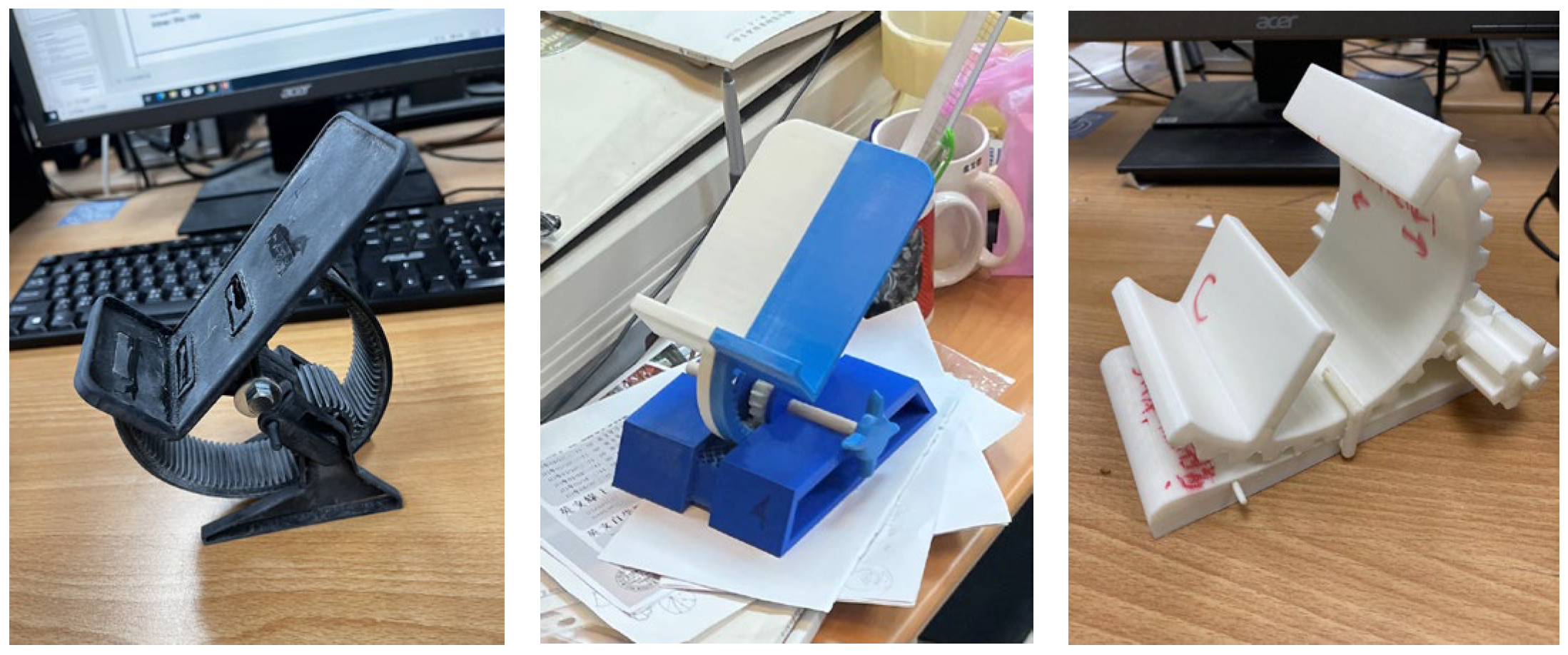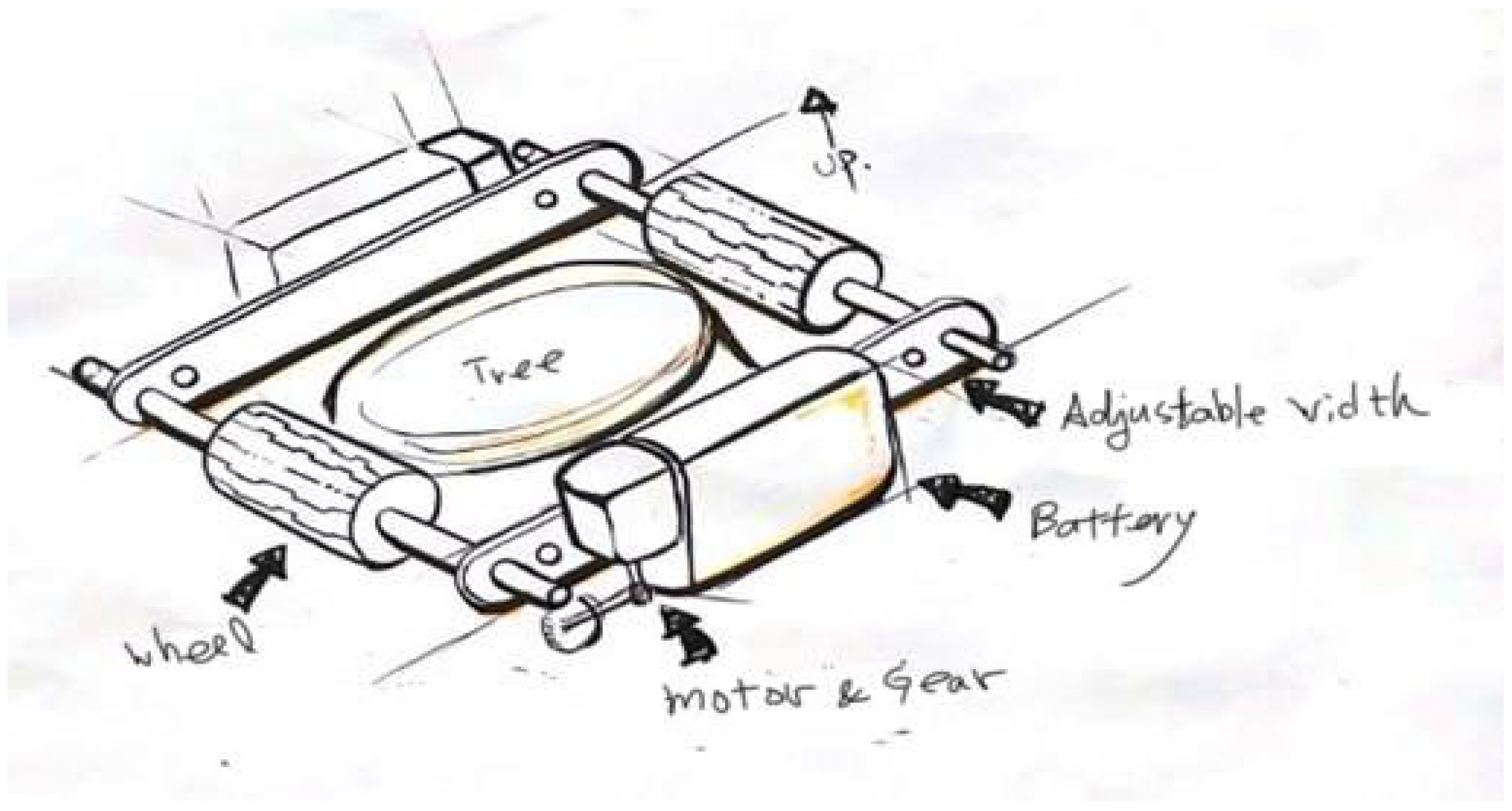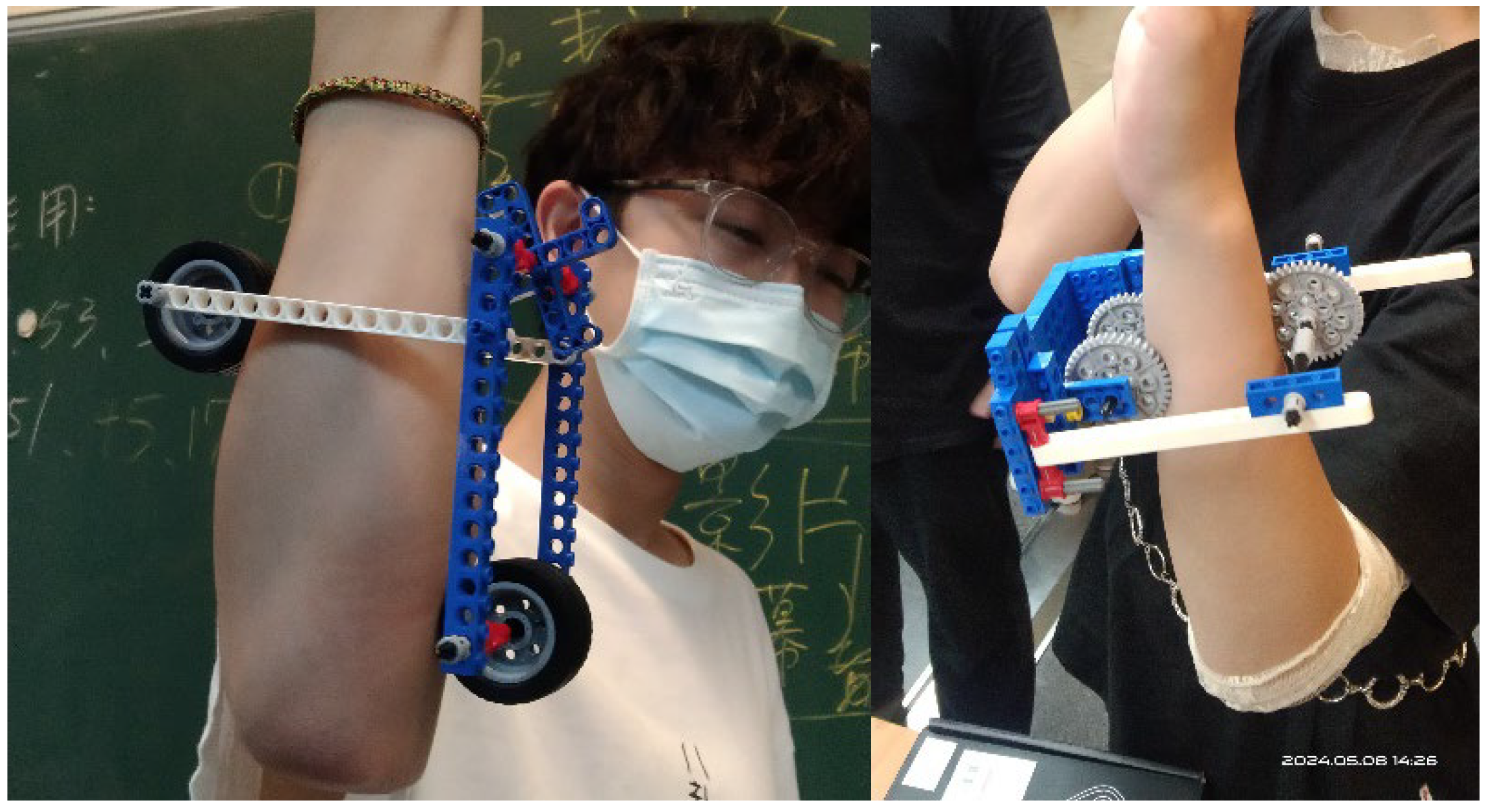1. Introduction
In regular classrooms, engineering-related courses are usually challenging for students majoring in design. Examination and course performance evaluation results indicate that students’ learning effectiveness in such courses is limited because they did not acquire sufficient engineering knowledge in high school. The textbook content fails to arouse students’ interest, making it difficult to stimulate their in-depth thinking about the course. This is particularly evident in the course “Practical Mechanism Design.” Students feel unfamiliar with and fearful of the course content, creating psychological barriers that are difficult to overcome due to their insufficient mathematical and physical knowledge, making it challenging to understand the relevant mechanical background knowledge. Additionally, students struggle to connect textbook diagrams with actual part designs, resulting in significant differences in learning effectiveness and an inability to meet the needs of students with varying levels of achievement.
In the rapid progress of technology and the abundance of online resources, a problem-based learning (PBL) method is incorporated into engineering-related courses in distance teaching. Through discussion and problem-solving, students can better understand the knowledge structure of mechanism design, thereby improving their learning interest and ability. In this study, the effects of the PBL method combined with hands-on learning on teachers’ teaching implementation and its impacts combined with hands-on learning on students’ learning were explored to make suggestions for integrating PBL combined with hands-on learning into engineering-related courses.
2. Literature Review
Recently, “learner-centered” teaching has become popular, and the PBL teaching method embodies the concept of returning the learning subject to students. The learning objectives of PBL include applying creative and critical thinking, improving communication skills, strengthening cooperative learning ability, developing self-exploration and responsible attitudes, enhancing knowledge-seeking and application abilities, and increasing students’ planning and control abilities. Fink reviewed various research and practices of applying PBL in engineering education and discussed its effects on improving students’ problem-solving abilities and cooperation skills [
1].
In the introductory engineering mechanics course of the “Sustainable Design” at Aalborg University in Copenhagen, Denmark, the PBL teaching method was applied for a semester [
2]. Real-world problems that do not have a single correct answer were assigned. Group project work supplemented traditional engineering education. Students needed to interpret problems on their own, collect the required information, determine possible solutions, evaluate options, and draw conclusions. The result of implementing PBL in this course was preliminarily evaluated, and challenges in implementing PBL in engineering and mathematics courses were discussed. PBL teaching requires a change in the traditional teacher-led model to a student-guided learning model, involving a significant change in teaching style. Therefore, teachers felt unaccustomed and lacked the corresponding guiding skills and experience [
3].
In engineering education, the main goals of PBL are to cultivate students’ analytical thinking, quick decision-making, and comprehensive abilities [
4]. For example, in engineering projects, students need to analyze problems, propose solutions, and make decisions within a limited time. Students also need to apply multidisciplinary knowledge to solve practical problems. Lai used a computer-aided design (CAD) system with parametric design functions to synchronously analyze planar mechanisms [
5]. The techniques were developed in a third-year course, “Machine Dynamics.” Geometric and dimensional constraints were applied to the skeleton diagram of the linkage mechanism created using standard graphic synthesis methods. Constraints for simulating the behavior of different types of joints were applied to the skeleton diagram to allow for the simulation of the mechanism’s operation. As part of the simulation, the paths of key points, such as coupling points, were drawn. The use of algebraic constraints to impose relationships between parameters was also discussed.
Teachers face difficulties in developing appropriate student evaluation criteria when managing PBL courses. Students need to be proactive in learning, interpret problems on their own, collect information, propose solutions, and conduct evaluations, placing high demands on their self-learning and problem-solving abilities. Several students lack these abilities, resulting in difficulties in PBL.
3. Instructional Design and Planning
In this study, the “tree-climbing mechanism” was selected as a teaching theme in the following four subtopics to help students complete learning tasks.
Design and production of a gear-based mobile phone stand: Apply gear-related knowledge to the design of a mobile phone stand.
Assembly and testing of the linkage mechanism: Use Lego bricks to complete the mid-term exam on the linkage mechanism.
Design and rough modeling of the tree-climbing mechanism: Understand the operation of the tree-climbing mechanism through handmade models.
Actual testing of the tree-climbing mechanism: Use handmade models or Lego bricks, combined with batteries and motors, to build a tree-climbing machine.
The course offered group practical sessions to solve specified problems. Each group consisted of three to five students. They solved the content of each subtopic through discussions within the group and with the teacher, enabling students to find appropriate solutions to the problems.
3.1. First Subtopic
Students were required to understand the engineering specifications and 3D manufacturing methods of gears and apply them to product design. The task was to design a “gear-based mobile phone stand” (
Figure 1). They adjusted the mobile phone angle by using gear meshing, with the following restrictive conditions: gear meshing, sturdy combination, easiness to adjust, and adjustable mobile phone angle.
3.2. Second Subtopic
Students understood the principle of the four-bar linkage mechanism, which served as the basis for the design of the tree-climbing mechanism in the final exam. Working in groups, students used Lego Technic bricks to complete the creation of five four-bar linkage models and carry out discussions and manufacturing within three hours (
Figure 2). They conducted computer-simulated practical operations.
3.3. Third Subtopic
Students verified the feasibility of the tree-climbing mechanism design with a rough model. In the first stage, students collected data on existing reference mechanisms to design a draft (
Figure 3) and assembled a scaled-down reference mechanism model with Technic bricks (
Figure 4). In the second stage, they made a 1:1 rough model of the mechanism and verified and adjusted the mechanism parameters through the model-making process. At this stage, students used only paper model boards or polyurethane foam boards as the main materials to make a 1:1 full-scale model (
Figure 5). Laser cutting or 3D printing was prohibited.
3.4. Fourth Subtopic
In the final exam, students carry out the practical production and verification of the tree-climbing mechanism and conduct on-site tests to measure the effect of the tree-climbing mechanism (
Figure 6).
4. Results and Discussion
In this study, the students took the course as co-participants in research on “PBL teaching in practical mechanism design” to explore practical problems and feasible methods for constructing engineering-related courses using the PBL teaching method. The research process included teaching activities and observations, with adjustments made to the teaching curriculum activities based on issues encountered during the teaching process. Students filled out a course feedback questionnaire and a learning reflection sheet at the end of the semester. The data were used to examine and reflect on the effectiveness and challenges of the PBL method combined with digital teaching materials in practical mechanism design. Self-reflection on the results of this action research was also analyzed to formulate strategies for subsequent research.
According to the questionnaire feedback, students’ acceptance of PBL was high. A total of 67.57% of the students agreed that PBL was helpful for learning mechanisms. However, the difficulty of problem-setting in PBL needs to be managed. In this semester’s mobile phone holder and tree climbing mechanism courses, mechanism, 72.98% of the students found the tasks difficult. Therefore, it is advisable to set a main problem, break it down into a series of sub-problems, and set restrictive conditions. This approach broadens students’ thinking, as observed during the course.
The acceptance of cooperative work exceeded 80%, effectively avoiding the dilemma of isolated learning. However, cooperative work leads to uneven workload distribution, causing exclusion within the group. This semester, two students were complained about by their group members due to their passive attitudes, ultimately leading to their withdrawal from the course. General kinematic courses usually use diagrams and computer software for teaching. However, proficiency in software commands often affects the correctness of the example implementation, reducing learning efficiency. Introducing hands-on model teaching aligns with the expertise of the design department and enables students to understand mechanism principles quickly and intuitively. Students majoring in design mainly focus on multimedia, advertising design, and art and craft. They self-assess their understanding of mechanical operations, spatial relationship abilities, and logical processing abilities as relatively weak, while their self-assessment of hands-on model-making and cooperative work abilities is above average.
For the first subtopic, 72.97% of the students agreed that the gear-based mobile phone stand was helpful for obtaining gear transmission assembly knowledge, and 67.57% agreed that group cooperation was helpful for the mobile phone stand assignment. For the second subtopic, 80.55% of the students agreed that “Lego bricks” helped them learn the linkage mechanism, but 62.16% found the mid-term assignment of completing the linkage mechanism with “Lego bricks” difficult, mainly due to the wide variety of Lego bricks, making it difficult. For the third subtopic, 67.57% of the students agreed that the handmade prototype was helpful for the design of the “tree-climbing mechanism.” At the end of the semester, 67.57% of the students believed that the course helped them learn the mechanism principles. The course reduced students’ repulsion towards future mechanism-related designs to 32.43%, indicating that the PBL course increased students’ confidence.
5. Conclusions
The PBL method enabled physical models to be more acceptable than virtual models, especially in engineering-related majors. Physical teaching aids are more effective than handmade models. In this study, off-the-shelf Lego Technic bricks were used as teaching aids, but due to the large variety of parts, it was difficult to start using them quickly. It is necessary to develop simplified Technic bricks based on bamboo sticks as prototype modular teaching materials. This was chosen by most students in the final prototype test, demonstrating its potential as a physical teaching aid for PBL teaching. Further research is required to extend the teaching methods of PBL and practical teaching aids to other engineering majors, such as Interaction and Digital Design and Advanced Computer-Aided Design. To teach more complex engineering knowledge, relevant courses such as numerical control and a complete cross-disciplinary training program, to provide education in design, electronics, and mechanics.










